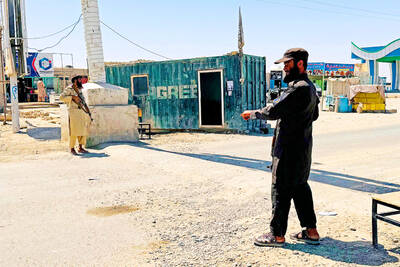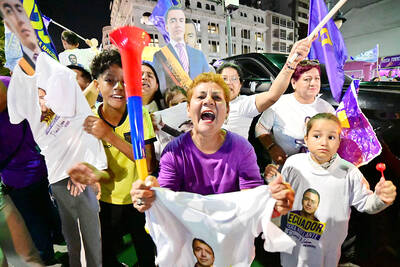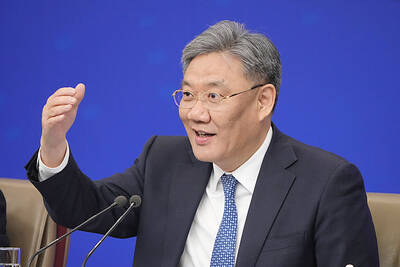Vladimir Chimitdorzhiyev was once an ardent communist who wanted to lead young people in Siberia to a Soviet paradise.
"That was a long time ago. All that is water under the bridge now," he said in his dimly lit retreat near Russia's border with Mongolia, ancient scrolls depicting Buddhist masters hanging over his shaved head.
"I am now a Buddhist monk. I've left irrelevant things behind. I've come here to learn and to teach," he said.
Tibetan teachings Chimitdorzhiyev helped revive in his ancestral homeland 6,000km southeast of Moscow are now at the forefront of a revival of interest in Buddhism in post-Soviet Russia.
After the Soviet collapse in 1991, Chimitdorzhiyev -- now known as Babu Lama -- returned to the rolling hills of his native Buryatia, brought together a dozen Buddhist priests and helped rebuild an old shrine.
Closed for decades in Soviet times, the Aginsk Datsan is now Russia's biggest Tibetan Buddhist temple.
"Peace has returned to this land ... But there was no peace here when the Datsan was closed," said Babu Lama, 46.
Under a fixed stare of a bronze statuette of Buddha, he looked out of a window and gazed at the temple's golden roofs.
Yellow banners with densely printed Tibetan inscriptions flapped in the wind, and worshippers chanted prayers inside the temple.
JAPANESE SPIES
Before Buddhism spread here from Tibet three centuries ago, Siberian tribes worshipped trees, animals and stones, their beliefs linked to other forms of Asian animism such as Japanese Shintoism.
For those tribes -- Buryats, Kalmyks and Tuvans -- Buddhism was their first source of education. In many ways, this is still the case in the most desolate villages like Aginskoye in this swathe of Siberia between Lake Baikal and Mongolia.
Following in his ancestors' footsteps, Babu Lama -- involved in various youth organizations in eastern Siberia in Soviet times -- reopened a Buddhist academy here to teach Buddhist ways to 50-odd disciples from all over Asia.
Russian Buddhism -- still linked to shamanism -- dates back to the 1700s when Empress Elizabeth, the liberal daughter of tsar Peter the Great, issued a decree recognizing Buryatia's Lamaistic beliefs and ordered the building of dozens of Buddhist temples.
Recognized as one of Russia's four official religions, Buddhism numbers 1 million followers in Russia, mainly in Buryatia -- a region once visited by the Tibetan spiritual leader, the Dalai Lama.
Both the Aginsk Datsan and the academy, built by Tibetan astrologists in the 19th century, were shut down in a clampdown on religion by Soviet dictator Josef Stalin in the 1930s.
Many lamas were arrested and deported to penal colonies, some accused of being Japanese spies.
Temples were turned into tuberculosis asylums to scare off believers.
The communists reopened a few temples after World War II to appease predominantly Buddhist tribes and even allowed theologians to travel to Mongolia to study.
BOHEMIAN PRETENSIONS
But it was only after the Soviet collapse that people like Babu Lama returned to Buryatia and Buddhist communities started to mushroom along the Mongolian border.
"And then we who doggedly carried Buddhism through the harsh Soviet years, gathered here in the 1990s and declared the temple open," said Lyubov Austermonas, a sinewy woman in her 50s and the Datsan's chief administrator.
Babu Lama's sanctuary in Buryatia -- one of Russia's poorest regions with an average monthly income of less than US$20 -- has now also turned into a fashionable travel destination for free-spending young Russians with Bohemian pretensions.
"We had this girl a few years ago, Vika from St Petersburg. She was a model," Austermonas said. "Tall, skinny and a bit conceited, she was one of those new Russians who can spend hundreds of dollars on rather useless adventures.
"But she went through this amazing transformation -- settled down in a hut, bought herself some cattle and plunged into Buddhism. She's now a famous theologian in our circles," she said.

‘EYE FOR AN EYE’: Two of the men were shot by a male relative of the victims, whose families turned down the opportunity to offer them amnesty, the Supreme Court said Four men were yesterday publicly executed in Afghanistan, the Supreme Court said, the highest number of executions to be carried out in one day since the Taliban’s return to power. The executions in three separate provinces brought to 10 the number of men publicly put to death since 2021, according to an Agence France-Presse tally. Public executions were common during the Taliban’s first rule from 1996 to 2001, with most of them carried out publicly in sports stadiums. Two men were shot around six or seven times by a male relative of the victims in front of spectators in Qala-i-Naw, the center

Incumbent Ecuadoran President Daniel Noboa on Sunday claimed a runaway victory in the nation’s presidential election, after voters endorsed the young leader’s “iron fist” approach to rampant cartel violence. With more than 90 percent of the votes counted, the National Election Council said Noboa had an unassailable 12-point lead over his leftist rival Luisa Gonzalez. Official results showed Noboa with 56 percent of the vote, against Gonzalez’s 44 percent — a far bigger winning margin than expected after a virtual tie in the first round. Speaking to jubilant supporters in his hometown of Olon, the 37-year-old president claimed a “historic victory.” “A huge hug

Canadian Prime Minister Mark Carney is leaning into his banking background as his country fights a trade war with the US, but his financial ties have also made him a target for conspiracy theories. Incorporating tropes familiar to followers of the far-right QAnon movement, conspiratorial social media posts about the Liberal leader have surged ahead of the country’s April 28 election. Posts range from false claims he recited a “satanic chant” at a campaign event to artificial intelligence (AI)-generated images of him in a pool with convicted sex offender Jeffrey Epstein. “He’s the ideal person to be targeted here, for sure, due to

DISPUTE: Beijing seeks global support against Trump’s tariffs, but many governments remain hesitant to align, including India, ASEAN countries and Australia China is reaching out to other nations as the US layers on more tariffs, in what appears to be an attempt by Beijing to form a united front to compel Washington to retreat. Days into the effort, it is meeting only partial success from countries unwilling to ally with the main target of US President Donald Trump’s trade war. Facing the cratering of global markets, Trump on Wednesday backed off his tariffs on most nations for 90 days, saying countries were lining up to negotiate more favorable conditions. China has refused to seek talks, saying the US was insincere and that it